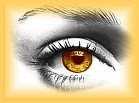http://www.graphicdesigndictionary.com/
Alias
When the curves and other lines in a graphic becomes jagged, the resolution of the graphics file is too low. The graphic is then referred to as "aliased".

Alignment
The align command is used to adjust the position of objects or text in relation to each other. The various ways objects or text can be aligned are typically left, right, center, top and bottom.
Anti-alias
Softening of the jagged edges in images that have become aliased.

bitmap (BMP)
Bitmap images are resolution dependent, unlike vector graphics which are resolution independent. A bitmap does not need to contain a bit of color-coded information for each pixel on every row. It only needs to contain information indicating a new color as the display scans along a row. This means that an image with much solid color will tend to require a small bitmap.
bleeding
When an image or printed color extends beyond the trimmed edge of a page, it is called a "bleed". Bleeding ensures that the print extends to the edges of the paper. The paper is usually trimmed to the desired size after printing.
canvas size
The full area of an image.
CMYK
CMYK stands for Cyan, Magenta, Yellow and Black, the four process color inks.

comp (comprehensive)
Comp's are made to see what a prospective design project will look like for example the layout of the image, use of color, the size and the paper that will be used. It is also named a dummy.
DPI (dots per inch)
DPI is the number of dots (or pixels - PPI) that fit horizontally and vertically into a one-inch measure. The more dots per inch, the more detail is captured and the sharper the image.
duotone
Duotones are made by printing an image with two colors, usually black and a second color. The resulting image has more depth than it would have had with only a monotone color (mostly black ink on white paper).
dummy
A dummy counts as an example of a piece of design work (brochure, ad, book cover etc.) that needs to be approved by the client. Once the client approves the dummy, the designer creates and prints the final design.
feathering
A graphic software tool used to make the edges of an image appear blurry.

font
A font is a complete set of characters in a particular style and typically consists of a full letter set, number set and all other special characters you get by pressing the shift, control or option keys. Examples of fonts include "Arial", "Courier New" etc.
GIF (Graphics Interchange Format)
GIF images display up to 256 colors. GIF images generally have very small file sizes and are the most widely used graphic format on the web. The low quality resulting from compression makes them unsuitable for professional printing.
gradient
A function in graphic software that allows the user to fill an object/image with a smooth transition of colors, for example a dark blue, gradually becoming lighter or red, gradually becoming orange, then yellow.

hue
Hue is the actual color of an object. Hue is measured as a pure color (on the color wheel) in degrees, for example degrees/variations of blue which is from a green-blue or sea-blue up to a purple-blue.
JPEG (Joint Photographic Electronic Group)
A common compression method that shrinks a file's storage size by discarding non-important picture detail. Excessive jpeg compression can cause poor image quality.
kerning
Adjusting the lateral (horizontal) space between letters.

line weight
Line weight is a term referring to the thickness of a printing line. Sometimes shapes are drawn with a line weight of zero and then the fill color is used to define the shape.
opacity
The density of a color or tonal value. The opacity of an image or object can range from transparent (0% opacity) to opaque (100% opacity). The ability to edit the opacity of individual objects allows the designer to create images that seem to flow into and through one another.
page layout
An example of a page layout is the pages in magazines or brochures. Every single page layout was created on a blank page by placing text, text columns, images etc. on the page. The whole design of a single page in a magazine is a page layout.
pixel
The smallest picture element (used to display an image on a computer), that can be independently assigned a color.
resolution
The resolution of an image is an important factor in determining the attainable output quality. The higher the resolution of an image, the less pixilated it will be and the curves of the image will appear smoother.
RGB (Red, Green, Blue)
RGB is the model used to project color on a computer monitor. By mixing these three colors, a large percentage of the visible color spectrum can be represented.
royalty-free photos or images
Intellectual property like photos and graphic images that are sold for a single standard fee. These can be used repeatedly by the purchaser only, but the company that sold the images usually still owns all the rights to it.
text wrap
A term used in page layout software, referring to the way text can be shaped around the edges of images.
vector graphic
Vector graphics are drawn in paths. This allows the designer to resize images freely without getting pixilated edges as is the case with bitmapped images. The vector format is generally used for in printing while the bitmap format is used for onscreen display.
.
No comments:
Post a Comment